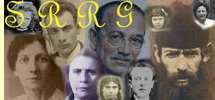|
May 22, 1915
You are invited to the wedding of
Lena Reiter and Adolph Blitzer

The engagement and marriage of Lena Reiter (age 18) and Adolph Blitzer (age25)
Adolph Blitzer, machine operator, rents 436 E. Woodruff St
Julius(designer)-Lena--Alice-Melba--Ralph--2021 Linwood Ave
Frances Reiter (Julius' daughter)--checker--Cohen-Friedlander & Martin Co, rents 2016 Canton Ave
Louis (tailor) and Millie move to Toledo, rent 2- family up and down. Children: Fanny-Sadie-Max-Harry 536 E. Woodruff St (outhouse)
Philip-Chana--Lena-Hyman (apprentice) 536 E. Woodruff St.
Max-Esther Leah Reinstein, house 206 W. Delaware Ave
Jacob Reinstein, tailor, rents 2023 Linwood
Louis Reinstein, tailor, house 2373 Vermont Ave
|
1915 was a time of transition for the Reiter family. The families were settling in, adjusting to being together and facing the realities of what this meant in terms of dollars and cents.
Julius bore the financial responsibility for his parents, sister Lena and brother Hyman. At this time, he had a wife and three children to support. Hyman, 23, found work and probably looked forward to moving out and getting on his own. Chana and Fischel aging, with little income, soon if not then would need more financial help from their sons. One of the biggest questions became what to do about Lena--who would support her?
If the ship manifest was correct, Chana and Fischel arrived in America with $1500.00 (equal to $26,431.17 in 2001)(1). It could have been $15.00, but there was no decimal. I believe my grandparents began living on this $1500.00 nest egg with supplements from Julius and Hyman. Lena, now close to her 18th birthday, wished to go to work as other young girls were doing. She wanted to be independent, go to school and train for something specific that would provide her a livelihood. More than that Lena wanted to be like Chana--educated and accomplished and win her mother's approval.
Career choices and opportunities for young women in 1915 were limited, especially for immigrants. Many turned to factory work in the garment industry such as blouse, hat making or general tailoring. In New York, March 27, 1911 a horrific fire at the Triangle Shirt Waist factory took the lives of 146 out of 500 employees. Whether this catastrophe or the idea of Lena working, especially in a factory, was not to their liking, the family decided the issue was out of the question.
The story (told to me by a cousin) goes the family informed Lena they had arranged for her to marry Adolph Blitzer. And when Lena cried she didn't want to, in fact was interested in another young man, her feelings were met with total disdain and resistance. Lena, having no mentor or advocate, complied.
Apprenticing at Fischel's tailor shop, Adolph was fond of Lena as he watched her grow up. She was lively, friendly, and outgoing. Adolph was seven years older--quiet, studious, and reserved. He arrived to Baltimore, Maryland in May, 1913, four months earlier than Lena and her parents. He traveled to New York and stayed with his paternal aunt, Ida Blitzer Held, whose husband owned a shirt waist factory. The Helds were hosts to many relatives emigrating from the old country. Adolph may have found work through them and his cousins, Jake and Max Blitzer, designers of womens suits and coats, but living conditions in New York (see Chapter 6, page 4, paragraph 3 - Life styles in the 1900s) did not live up to the myth that the "streets were paved with gold".
Julius secured a job for my father at the Cohn-Friedlander, and Martin company. Whether this came about before or because of the engagement, I don't know. Moving to Toledo would be advantageous as it reunited Adolph with his maternal grandfather, Frank Reinstein-Zuker and members of that family.
The wedding plans began. Caterers were called. Lena's sister-in-law, Millie Trager Reiter(2) was a wonderful cook and my childhood friend's(3) grandmother, "Bubbe Schaner"(4) was engaged to prepare her specialties, too. My grandmother Chana, true to Orthodox beliefs, was consummed with Lena's "virginity and that she partake of the mikvah".(5)
Adolph gave Lena a diamond ring. The hall was rented, filled with guests eating and dancing. The couple, dressed in proper attire, were photographed and married by Rabbi T. M. Silberman of the Orthodox Synagogue, Anshei Sfard.
The start of a new life for Lena and Adolph was celebrated and recorded. Lena placed a few of her wedding roses in the family bible and a new chapter in the Reiter-Blitzer family history was about to be written.
|
Next Page . . .
 |
|
Home -
Introduction -
Prologue -
Preface -
Table of Contents -
Chapter 1 -
Chapter 2 -
Chapter 3 -
Chapter 4 -
Chapter 5 -
Chapter 6 -
Chapter 7 -
Chapter 8 -
Chapter 9 -
Chapter 10 -
Guest Book -
References
|
|





